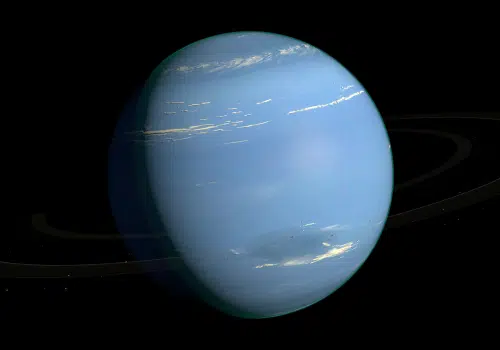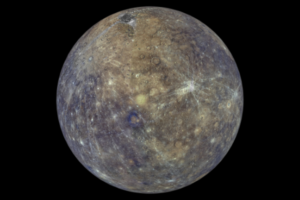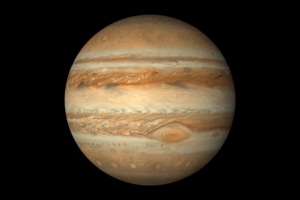Exploring the Mysteries of Neptune: A Planetary Odyssey

Neptune is one of the most mysterious and intriguing planets in our solar system.
It is the eighth planet from the Sun and the farthest from our star, and it has many unique features that make it a fascinating subject of study.
In this blog post, we will explore ten of the most unique characteristics of Neptune, including its size, composition, moons, rings, magnetic field, weather, discovery and exploration, tridents, and seasons.
Key Takeaways:
Charcteristics of Neptune
- Neptune is the farthest planet from the Sun in our solar system.
- It is a gas giant, made up primarily of hydrogen and helium, with a small rocky core.
- Neptune has a distinctive blue color due to the presence of methane in its atmosphere.
- The planet has 14 known moons, with Triton being the largest and most unusual.
- Neptune’s magnetic field is incredibly strong, and it is tilted at an angle of about 47 degrees relative to its axis of rotation.
Size and Distance
Neptune is the fourth-largest planet in our solar system, with a diameter of about 49,244 kilometers. It is slightly smaller than Uranus but larger than Earth.
Neptune is located about 4.5 billion kilometers away from the Sun, which is almost 30 times farther away than Earth.
Due to its distance from the Sun, Neptune is very cold, with an average temperature of about -200 degrees Celsius.
Its extreme distance also means that it has a very long year, lasting about 165 Earth years.
Composition
Neptune is a gas giant planet, which means that it is primarily composed of hydrogen and helium, with small amounts of methane, ammonia, and water vapor.
Its atmosphere is much denser than Earth’s atmosphere, and it is composed of several layers of clouds, with the topmost layer being made up of methane ice crystals.
Below the clouds, Neptune’s mantle is thought to be composed of water, ammonia, and methane, while its core is made up of rock, metal, and ice.
Moons and Rings
Neptune has 14 known moons, the largest of which is Triton, which is thought to have been captured by Neptune’s gravitational pull.
Triton is a unique moon in many ways, including the fact that it is the only large moon in the solar system that orbits its planet in a retrograde direction, which means that it orbits in the opposite direction to Neptune’s rotation.
Triton is also thought to be geologically active, with volcanic activity and geysers of nitrogen gas and dust.
Neptune also has a faint system of rings, which were discovered by Voyager 2 in 1989.
The rings are composed of dust and small rocks, and they are thought to be relatively young, as they are not as well-defined as the rings of other gas giant planets.
The origin of Neptune’s rings is not yet fully understood, but it is thought that they may have been formed by the collision of two or more of Neptune’s moons.
Magnetic Field
Neptune has a strong magnetic field, which is about 27 times stronger than Earth’s magnetic field.
The magnetic field of Neptune is also highly tilted, which means that its magnetic poles are located far from its geographic poles.
This creates a complex and dynamic magnetosphere around the planet, which interacts with the solar wind and creates auroras in Neptune’s atmosphere.
Weather and Climate
Neptune has some of the most extreme weather in the solar system, with winds that can reach up to 2,000 kilometers per hour.
The planet also has massive storms, including the famous Great Dark Spot, which is a giant storm system that is about the size of Earth.
Neptune’s strong winds and storms are thought to be caused by its rapid rotation and its atmosphere, which is composed of hydrogen, helium, and methane.
Discovery and Exploration
Neptune was the first planet to be discovered through mathematical prediction, rather than through direct observation.
In 1846, the French astronomer Urbain Le Verrier used mathematical calculations to predict the existence and location of a new planet beyond Uranus.
Based on his predictions, the German astronomer Johann Galle was able to observe Neptune for the first time using a telescope.
Since its discovery, Neptune has been visited by only one spacecraft, Voyager 2, which flew by the planet in 1989.
During its flyby, Voyager 2 was able to gather a wealth of information about Neptune’s atmosphere, moons, rings, and magnetic field.
However, due to its distance from Earth, there are no current plans to send a new mission to Neptune.
Tridents
One of the most unique and mysterious features of Neptune is the presence of “tridents” in its atmosphere.
These tridents are three-pronged features that appear to be made up of methane ice crystals, and they are thought to be created by powerful storms and vortices in the planet’s atmosphere.
The exact mechanism behind the formation of tridents is not yet fully understood, but their striking appearance has made them a popular subject of study among planetary scientists.
Seasons
Like all planets in our solar system, Neptune experiences seasons due to its axial tilt. However, due to its extreme distance from the Sun, Neptune’s seasons are much longer than those of Earth.
Each season on Neptune lasts for about 40 Earth years, and the planet is currently in its southern hemisphere summer.
During the summer months, Neptune’s southern hemisphere is tilted toward the Sun, causing increased solar radiation and a rise in temperature.
FAQs
What is the temperature on Neptune?
Neptune is one of the coldest planets in our solar system, with an average temperature of about -200 degrees Celsius.
How many moons does Neptune have?
Neptune has 14 known moons, the largest of which is Triton.
What are tridents on Neptune?
Tridents are three-pronged features that appear to be made up of methane ice crystals in Neptune’s atmosphere, and they are thought to be created by powerful storms and vortices.
How long is a day on Neptune?
A day on Neptune lasts about 16 hours and 6 minutes.
Can we live on Neptune?
No, we cannot live on Neptune. The extreme cold, lack of breathable air, and lack of solid ground make Neptune an inhospitable environment for humans.
Conclusion
In conclusion, Neptune is a fascinating planet with many unique characteristics that make it a subject of great interest to planetary scientists.
From its size and composition to its moons, rings, and magnetic field, Neptune has much to offer in terms of scientific discovery and exploration.
While we have much to learn about this distant planet, the information gathered from Voyager 2’s flyby and ongoing research efforts promises to shed light on the mysteries of Neptune for years to come.
Written by:

Kavya Joshi
My love affair with space began in a field in India at the age of 7, when I looked up at the Milky Way for the first time. Ever since, I have been attempting to cram in every fact about the Universe, I can find into my head.
ABOUT US
We are a team of active amateur astronomers, here to help you with all your astronomy and science related needs – this is anything, from reviewing the latest telescopes to be released to talking about gravity and neurons. The Big Bang Optics was started because of our love for astronomy and to help others like us find the best telescope and accessories.
LEGAL DISCLAIMER
The Big Bang Optics is a participant in the Amazon Services LLC Associates Program, an affiliate advertising program designed to provide a means for sites to earn advertising fees by advertising and linking to Amazon.com. The Big Bang Optics also participates in affiliate programs with Clickbank and other sites. The Big Bang Optics is compensated for referring traffic and business to these companies.




